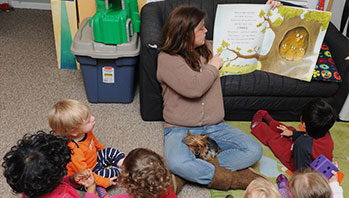- Mama Zooms (book)
- down
- fast
- ramp
- roll
- slant
- slide (v.)
- steep
- up
- zoom
MA Standards:
English Language Arts/Literature/RL.PK.MA.1: With prompting and support, ask and answer questions about a story or a poem read aloud.
English Language Arts/Literature/RL.PK.MA.4: With prompting and support, ask and answer questions about unfamiliar words in a story or poem read aloud.
English Language Arts/Literature/RL.PK.MA.9: With prompting and support, make connections between a story or poem and one’s own experiences.
English Language Arts/Literature/RL.PK.MA.2: With prompting and support, retell a sequence of events from a story read aloud.
English Language Arts/Language/L.PK.MA.1.e: Use the most frequently occurring prepositions (e.g., to, from, in, out, on, off, for, of, by, with).
English Language Arts/Foundational Skills/RF.PK.MA.1.d: Recognize and name some uppercase letters of the alphabet and the lowercase letters in one’s own name.
Head Start Outcomes:
Literacy Knowledge/Alphabet Knowledge: Recognizes that the letters of the alphabet are a special category of visual graphics that can be individually named.
Literacy Knowledge/Book Appreciation and Knowledge: Asks and answers questions and makes comments about print materials.
PreK Learning Guidelines:
English Language Arts/Reading and Literature 7: Develop familiarity with the forms of alphabet letters, awareness of print, and letter forms.
English Language Arts/Reading and Literature 6: Listen to a wide variety of age appropriate literature read aloud.
English Language Arts/Reading and Literature 10: Engage actively in read-aloud activities by asking questions, offering ideas, predicting or retelling important parts of a story or informational book.
Read Together: Mama Zooms #1

© Commonwealth of Massachusetts, Department of Early Education and Care (Jennifer Waddell photographer). All rights reserved.
STEM Key Concepts: Understand that a ramp, or inclined plane, is a surface with one end higher than the other; Recognize that an object placed on an inclined plane will roll, slide, or stay put; Identify tools and simple machines used for a specific purpose, e.g., ramp, wheel, pulley, lever
ELA Focus Skills: Active Listening, Concepts of Print, Interpret Illustrations, Make Connections, Story Comprehension, Vocabulary
Display the front cover of Mama Zooms by Jane Cowen-Fletcher and then display the back cover.
- Discuss with children how some people cannot walk and that a wheelchair helps them move around and go places.
- Explain that in Mama Zooms a boy likes to ride with his Mama in her “zooming machine.”
Set a focus for children by having them look for all the places the boy and his Mama go—and to notice the hills and ramps they climb up and zoom down. Say, As you look at the pictures, tell me if you see anything that looks like a ramp.
Before You Read
Focus on the front cover and ask children to point to the title and the name of the author. Read the title aloud.
- Have children point to any letters they recognize in the title or the author’s or illustrator’s names.
- Have children read the title with you again and ask children what word in the title means “to go really fast.”
As You Read
Read slowly and with expression. Turn the book around so children can look at the illustrations as you read.
- Pause and point to the illustration showing the wheelchair zooming down the ramp. Ask, What do you notice about how the wheelchair is moving down the ramp? Why do you think the wheelchair rolls instead of slides down the ramp? (wheels roll)
- Review the adjectives relating to surfaces that children learned in the sound unit and relate them to the surfaces mentioned in the story: smooth sidewalks, bumpy road, steepest hills. Ask questions such as, Do you think Mama’s wheelchair rolls more quickly on a smooth surface or on a bumpy surface? Why do you think that?
- Explain the meaning of terms that children may not be familiar with, such as “ocean boardwalk.” (An ocean boardwalk is like a sidewalk along the edge of a beach.)
After You Read
Ask questions such as,
- Why do you think the boy and his father push Mama up the very steepest hills? (It takes more strength to get up the hills that slant way up.)
- Why do you think Mama and the boy go faster down the ramp than they go across the sidewalk?
English Language Learners: If children are having trouble understanding what steepest means, draw three ramps of ascending steepness for them, or guide their fingers as they draw the lines themselves. Have children trace the steepest ramp with their fingers as you have them say the word steepest.
